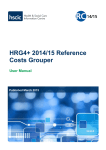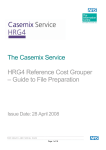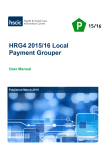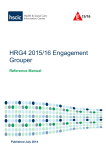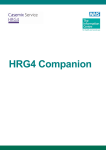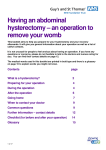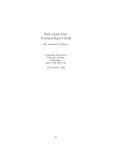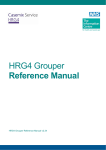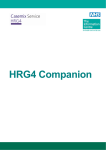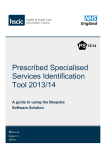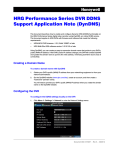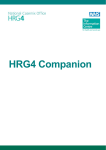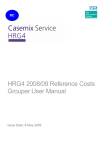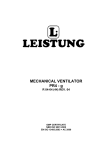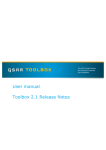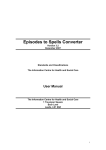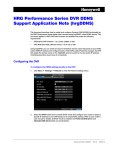Download HRG4+ 2013/14 RC Trimpoints Methodology
Transcript
HRG4+ Reference Cost Grouper Methodology for the generation of HRG Trimpoints for reporting in Reference Costs Last Updated: 10th January 2014 1 Copyright © 2014, Health and Social Care Information Centre. Methodology for the generation of HRG Trimpoints for reporting in Reference Costs Contents Introduction 3 Episode Trimpoints for Reporting 3 Spell Trimpoints for informing national pricing 3 Trimpoint Calculation Methodology 3 Source Data 3 Aggregates 4 Definition of trimpoints 4 Adjustment for small numbers 5 Preset Trimpoints 5 Assurance 5 Testing Procedure 5 Analysis 6 Step 1 6 Step 2 6 Specification of the Trimpoints File 7 Changes from RC1213 7 2 Copyright © 2014, Health and Social Care Information Centre. Methodology for the generation of HRG Trimpoints for reporting in Reference Costs Introduction Admitted Patient Care (APC) data often contains episodes with an exceptionally long length of stay, which have a disproportionate effect on the mean length of stay. In order to improve comparability, such episodes are removed prior to statistical analysis. This process is referred to as trimming and the thresholds for exclusion are known as trimpoints. Episodes or spells with a length of stay above the trimpoint are known as outliers. In both National pricing and Reference Cost reporting, trimpoints are used to define a threshold: bed days occurring within the trimpoint (truncated bed days) and bed days occurring above the trimpoint (excess bed days) are reported, costed and priced separately. Suppose for example an HRG has a trimpoint of 32 days An episode whose length of stay is 50 days is reported as 32 truncated bed days and 18 excess bed days. An episode whose length of stay is 31 days is reported as 31 truncated bed days and no excess bed days. Episode Trimpoints for Reporting Truncated episode length of stay and excess bed days are reported separately in Reference Costs. The Grouper therefore includes a set of episode level trimpoints for this purpose at the HRG level. There is no policy requirement for these trimpoints to be split by admission method. Spell Trimpoints for informing national pricing The Reference Cost process is used to inform Monitor / NHS England for the purposes of setting the tariff. Tariffs are set at spell level and are split by admission method. The Mandatory tariff applies only to spell length of stay up to the trimpoint, and a per diem rate is used for excess bed days. The Reference Cost grouper therefore includes a set of spell trimpoints, split by admission method, for this purpose. Trimpoint Calculation Methodology Source Data Trimpoints are calculated from episodes and spells in the Hospital Episodes Statistics (HES) Admitted Patient Care (APC) extract for the previous financial year (i.e. 2012/13 for 2013/14 Reference Costs). 1. The data is preprocessed and ‘PbR spells’ are constructed according to the Spelling and Grouping Methodology workshop (11th January 2010). 2. The episodes are selected for inclusion in the analysis satisfy the following criteria a. The episode must have valid start and end dates with the episode ending within the financial year 3 Copyright © 2014, Health and Social Care Information Centre. Methodology for the generation of HRG Trimpoints for reporting in Reference Costs b. The record is an inpatient episode (CLASSPAT 1 or 5) c. The following treatment function codes (TRETSPEF) are excluded: 192 Critical Care Medicine 242 Paediatric Intensive Care 314 Rehabilitation 315 Palliative Medicine 422 Neonatology 424 Well Babies 3. Spells are regarded as elective if the admission method in the first episode available for grouping (when sorted by episode order and epikey) is 11, 12 or 13. Other spells are regarded as non-elective. The selected episodes are grouped using the assured grouping enginei. Although spell grouping is for ‘PbR spells’, only these episodes will contribute to the spell HRG and length of stay Aggregates Trimpoints are calculated for the following aggregates: 1. Episodes, for each HRG 2. Elective spells, for each HRG 3. Non-elective spells, for each HRG Definition of trimpoints Trimpoints are determined by the upper and lower quartiles as follows: TP Q3 1.5Q3 Q1 Since there is more than one accepted mathematical definition of quartiles, because they are determined by interpolation, a decision has been taken to define them as follows ii: 12 x j x j 1 if n is divisible by 4 Q1 otherwise x j 1 1 x xk 1 if 3n is divisible by 4 Q3 2 k otherwise xk 1 Trimpoints are rounded to the nearest integer. Calculation of trimpoints by the above formula will mean that all trimpoints will be multiples of 0.5; therefore those which are half integers will be rounded above. If the trimpoint is calculated as zero, then it is changed to one. This reflects the treatment of zero length of stay episodes as being counted as one bed day in Reference Cost submissions. 4 Copyright © 2014, Health and Social Care Information Centre. Methodology for the generation of HRG Trimpoints for reporting in Reference Costs Adjustment for small numbers For HRGs with low activity, trimpoints do not apply. Instead the trimpoint is set to infinity so that no bed days are regarded as being excess. For the purposes of the Grouper, 32000 is used as the infinite trimpoint. This applies in the following circumstances: HRGs that exist but for which there was no activity in that year HRGs where the number of cases is less than 5 HRGs where the number of cases is between 5 and 30, and the calculated trimpoint would exclude less than 5% or more than 15% of the total bed days for those cases. Please note: for HRGs where the number of cases is between 5 and 30, and the calculated trimpoint would exclude between 5% and 15% of the total bed days the trimpoint remains as the calculated trimpoint Preset Trimpoints In certain circumstances, there is a possibility that a trimpoint may be preset by DH, regardless of what is calculated. At present the following trimpoints are preset: 1. HRGs that have length of stay logic that includes a maximum length of stay value / range (including where that maximum is zero days) have a trimpoint of infinity (32000) 2. HRGs which are ambulatory; i.e. all the codes going to them have an implied zero (or maximum) length of stay have a trimpoint of infinity (32000) 3. The ungrouped UZ01Z has trimpoint of infinity (32000) so that they have no excess bed daysiii 4. The non-admitted consultations (chapter WF) should have a zero trimpoint because they should never be generated in APCiv 5. All unbundled HRGs have zero trimpoints because they will never be generated as core HRGs. These occur in chapters LE, RA, SB (except SB97Z), SC (except SC97Z), SD, VC, XD and the critical care transportation HRGs (XA06Z and XB08Z) 6. The HRGs in non-APC chapters LD, VB, XA, XB and XC should have zero trimpoints because they cannot be generated in APC 7. ZZ01Z has a zero trimpoint because it should never be generated in APC (if everything is unbundled, the core HRG will be driven off the primary diagnosis) N.B. Preset trimpoints affect the episode, elective spell and non-elective spell trimpoints of the same HRG. Assurance Testing Procedure The following checks are made on the final trimpoints file before being offered for publication and incorporation in the HRG4+ Reference Cost Grouper. 5 Copyright © 2014, Health and Social Care Information Centre. Methodology for the generation of HRG Trimpoints for reporting in Reference Costs 1. Every HRG, whether or not it can be reached as the core APC HRG, must have a trimpoint (those which are not reachable will be set to zero). 2. All trimpoints should be set to their preset values whenever a preset trimpoint is applicable. 3. All preset trimpoints are correctly applied 4. Trimpoints are clinically realistic e.g. 50 days for a heart and lung transplant (usually long stay) or 2 days for a cataract operation (usually day case) Analysis The purpose is to provide confidence in the new trimpoints with regard to what has been previously published. Comparing this year’s trimpoints directly with last year’s is not meaningful because both the HRG design and source data used to calculate them are different and there is often a large volume of changes between the designs. In order to make more meaningful comparisons, a second set of trimpoints is calculated using the prospective design database but using the same data as was used to produce last year’s trimpoints; i.e. the financial year two years behind the database. The sets of trimpoints will be referred as follows: Set 1: Trimpoints produced for publication this year e.g. RC1314 on 1213HES Set 2: Trimpoints with this year’s database but the same data as last year’s trimpoints e.g. RC1314 on 1112HES Set 3: Last year’s trimpoints e.g. RC1213 on 1112HES Step 1 Comparing Set 2 and Set 3 HRG by HRG identifies changes in trimpoints caused by changes to HRG design. Only HRGs which exist in both designs can be compared and trimpoints of HRGs with no activity entering or leaving then between the designs should have unchanged trimpoints. Step 2 Comparing Set 1 and Set 2 HRG by HRG identifies changes in trimpoints caused by changes to the underlying data. There will always be some changes to trimpoints and those which differ by more than 3 days and have a percentage increase/decrease of more than 20% should be identified as significant. There are usually around 20 HRGs with more than 600 episodes going to them which have significant changes. Such changes are best explained by HRG designers who have a good working clinical knowledge. Possible explanations for changes are: 1. Change in clinical practice e.g. more operations being carried out laparoscopically 2. Increase in take up of new OPCS codes increasing the likelihood of HRGs dependent on these codes being assigned 3. Change in data quality i.e. significant change in the number of U-groups being assigned 4. On occasions, a quartile may be borderline and therefore the trimpoint becomes sensitive to a small change in this quartile 6 Copyright © 2014, Health and Social Care Information Centre. Methodology for the generation of HRG Trimpoints for reporting in Reference Costs Specification of the Trimpoints File The trimpoints file is made available for publication as an Excel spreadsheet. It consists of the following columns Column Heading Description A HRG Split level HRG4+ code B HRG_Description HRG description C Trimpt_Preset Preset trimpoint. If no preset is applicable then this field is blank D Trimpt_Episode Episode level trimpoint E Trimpt_Spell_EL Elective spell trimpoint F Trimpt_Spell_NE Non-elective spell trimpoint A row is present for every HRG in the reference database, even if it cannot be generated as a core APC HRG. Changes from RC1213 RC1314 is the first year in which spell trimpoints are split by admission method. The episode-spell consistency adjustment, which previously enforced that a spell trimpoint for any HRG cannot be lower than the episode trimpoint for the same HRG, is no longer applied due to the aggregates for the two currencies being different. Comparative analysis for spell based trimpoints is meaningless because the aggregates have changed due to the admission method split. i Casemix operates a testing grouping engine which is used to test and assure the HRG Grouper. This grouping engine, with the prospective HRG Reference Database, is used to group the HES extract for production of trimpoints. ii This is the default method used by statistical packages including SAS (but not Excel). The trimpoints are actually calculated by SQL Server queries. iii This is a new DH requirement as of 2012/13 (previously it was set to zero) which affects the way that excess bed days are reported in Reference Costs. For payment purposes it does not actually matter what the trimpoint of UZ01Z is because that HRG code has a zero tariff assigned to it. iv The only way of generating these HRGs is from X62 OPCS codes which are not supposed to be used in APC, according to National Coding Guidance. 7 Copyright © 2014, Health and Social Care Information Centre. Methodology for the generation of HRG Trimpoints for reporting in Reference Costs The Documentation Suite Below is a list of the various documents which are available to download from the National Casemix Office website www.hscic.gov.uk/casemix. It is a comprehensive resource of supporting materials, designed to assist users in understanding the design concepts, logic and practical use of the Grouper. The Casemix Companion is a starting point and general reference for new and existing users, providing an introduction to HRGs, groupers, HRG4+ design concepts and grouping logic and useful links to further information The Grouper Reference Manual provides full instructions on how to prepare and group data using the Grouper software application. This generic document is updated with every new grouper software toolkit released The Summary of Changes document provides an overview of the main changes between the current grouper design and its predecessor The Roots Workbook is a spreadsheet that identifies new HRGs, deleted HRGs and changes to existing HRG Labels between each release of the classification, using an easy to follow colour-coding system The Chapter Summaries document provides an overview of the scope, composition and grouping logic of individual subchapters along with illustrative worked examples. Also included in the document are updates on the changes within subchapters The Code to Group Workbook is a spreadsheet that provides details on all mappings between primary classification (e.g. ICD-10, OPCS-4, A&E codes, etc.) and their respective HRGs. Also detailed within the workbook are the logic conditions required to generate the HRGs The Code to Group User Manual serves as an introduction to using the Code to Group workbook to perform manual grouping. It also details some basic design concepts and provides worked examples of a variety of different grouping scenarios The Specialised Service Identification Code Sets is a workbook containing details regarding the flags and trigger codes introduced in the HRG4+ Reference Costs Grouper to aid identification of specific Specialised Service activity. 8 Copyright © 2014, Health and Social Care Information Centre.








